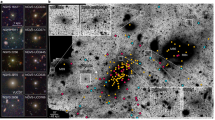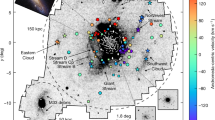Abstract
Recent studies have found that the oldest and most luminous galaxies in the early Universe are surprisingly compact1,2,3,4,5,6,7, having stellar masses similar to present-day elliptical galaxies but much smaller sizes. This finding has attracted considerable attention8,9,10,11,12,13, as it suggests that massive galaxies have grown in size by a factor of about five over the past ten billion years (10 Gyr). A key test of these results is a determination of the stellar kinematics of one of the compact galaxies: if the sizes of these objects are as extreme as has been claimed, their stars are expected to have much higher velocities than those in present-day galaxies of the same mass. Here we report a measurement of the stellar velocity dispersion of a massive compact galaxy at redshift z = 2.186, corresponding to a look-back time of 10.7 Gyr. The velocity dispersion is very high at  km s-1, consistent with the mass and compactness of the galaxy inferred from photometric data. This would indicate significant recent structural and dynamical evolution of massive galaxies over the past 10 Gyr. The uncertainty in the dispersion was determined from simulations that include the effects of noise and template mismatch. However, we cannot exclude the possibility that some subtle systematic effect may have influenced the analysis, given the low signal-to-noise ratio of our spectrum.
km s-1, consistent with the mass and compactness of the galaxy inferred from photometric data. This would indicate significant recent structural and dynamical evolution of massive galaxies over the past 10 Gyr. The uncertainty in the dispersion was determined from simulations that include the effects of noise and template mismatch. However, we cannot exclude the possibility that some subtle systematic effect may have influenced the analysis, given the low signal-to-noise ratio of our spectrum.
This is a preview of subscription content, access via your institution
Access options
Subscribe to this journal
Receive 51 print issues and online access
$199.00 per year
only $3.90 per issue
Buy this article
- Purchase on Springer Link
- Instant access to full article PDF
Prices may be subject to local taxes which are calculated during checkout


Similar content being viewed by others
References
Trujillo, I. et al. The size evolution of galaxies since z ∼ 3: combining SDSS, GEMS, and FIRES. Astrophys. J. 650, 18–41 (2006)
Toft, S. et al. Hubble Space Telescope and Spitzer imaging of red and blue galaxies at z ∼ 2.5: a correlation between size and star formation activity from compact quiescent galaxies to extended star-forming galaxies. Astrophys. J. 671, 285–302 (2007)
van Dokkum, P. G. et al. Confirmation of the remarkable compactness of massive quiescent galaxies at z ∼ 2.3: early-type galaxies did not form in a simple monolithic collapse. Astrophys. J. 677, L5–L8 (2008)
Cimatti, A. et al. GMASS ultradeep spectroscopy of galaxies at z ∼ 2. II. Superdense passive galaxies: how did they form and evolve? Astron. Astrophys. 482, 21–35 (2008)
van der Wel, A. et al. Recent structural evolution of early-type galaxies: size growth from z = 1 to z = 0. Astrophys. J. 688, 48–58 (2008)
Franx, M. et al. Structure and star formation in galaxies out to z = 3: evidence for surface density dependent evolution and upsizing. Astrophys. J. 688, 770–788 (2008)
Damjanov, I. et al. Red nuggets at z ∼ 1.5: compact passive galaxies and the formation of the Kormendy relation. Astrophys. J. (in the press); preprint at 〈http://arXiv.org/abs/0807.1744〉 (2008)
Naab, T., Johansson, P. H., Ostriker, J. P. & Efstathiou, G. Formation of early-type galaxies from cosmological initial conditions. Astrophys. J. 658, 710–720 (2008)
Fan, L., Lapi, A., De Zotti, G. & Danese, L. The dramatic size evolution of elliptical galaxies and the quasar feedback. Astrophys. J. 689, L101–L104 (2008)
Bezanson, R. et al. The relation between compact, quiescent high redshift galaxies and massive nearby elliptical galaxies: evidence for hierarchical, inside-out growth. Astrophys. J. (in the press); preprint at 〈http://arXiv.org/abs/0903.2044〉 (2009)
Naab, T., Johansson, P. H. & Ostriker, J. P. Minor mergers and the size evolution of elliptical galaxies. Astrophys. J. (submitted); preprint at 〈http://arXiv.org/abs/0903.1636〉 (2009)
van der Wel, A., Bell, E. F., van den Bosch, F. C., Gallazzi, A. & Rix, H.-W. On the size and co-moving mass density evolution of early-type galaxies. Astrophys. J. (submitted); preprint at 〈http://arXiv.org/abs/0903.4857〉 (2009)
Hopkins, P. F. et al. Compact high-redshift galaxies are the core of present-day massive spheroids. Astrophys. J. (submitted); preprint at 〈http://arXiv.org/abs/0903.2479〉 (2009)
Kriek, M. et al. An ultra-deep near-infrared spectrum of a compact quiescent galaxy at z = 2.2. Astrophys. J. (in the press); preprint at 〈http://arXiv.org/abs/0905.1692〉 (2009)
Kriek, M. et al. Spectroscopic identification of massive galaxies at z ∼ 2.3 with strongly suppressed star formation. Astrophys. J. 649, L71–L74 (2006)
Kriek, M. et al. A near-infrared spectroscopic survey of K-selected galaxies at z ∼ 2.3: redshifts and implications for broadband photometric studies. Astrophys. J. 677, 219–237 (2008)
Franx, M., Illingworth, G. & Heckman, T. Major and minor axis kinematics of 22 ellipticals. Astrophys. J. 344, 613–636 (1989)
van Dokkum, P. G. & Stanford, S. A. The fundamental plane at z = 1.27: first calibration of the mass scale of red galaxies at redshifts z > 1. Astrophys. J. 585, 78–89 (2003)
Bernardi, M. et al. A search for the most massive galaxies: double trouble? Astron. J. 391, 1191–1199 (2006)
Bernardi, M. et al. A search for the most massive galaxies – II. Structure, environment, and formation. Mon. Not. R. Astron. Soc. 391, 1191–1199 (2008)
Cenarro, A. & Trujillo, I. Mild velocity dispersion evolution of spheroid-like massive galaxies since z ∼ 2. Astrophys. J. 696, L43–L46 (2009)
Dekel, A. et al. Cold streams in early massive hot haloes as the main mode of galaxy formation. Nature 457, 451–454 (2009)
Greve, T. R. et al. An interferometric CO survey of luminous submillimetre galaxies. Mon. Not. R. Astron. Soc. 359, 1165–1183 (2005)
Bertoldi, F. et al. High-excitation CO in a quasar host galaxy at z = 6.42. Astron. Astrophys. 409, L47–L50 (2003)
Narayanan, D. et al. The nature of CO emission from z ∼ 6 quasars. Astrophys. J. 174 (Supp.). 13–30 (2008)
Boylan-Kolchin, M., Ma, C.-P. & Quataert, E. Red mergers and the assembly of massive elliptical galaxies: the fundamental plane and its projections. Mon. Not. R. Astron. Soc. 369, 1081–1089 (2006)
Ferrarese, L. & Merritt, D. A fundamental relation between supermassive black holes and their host galaxies. Astrophys. J. 539, L9–L12 (2000)
Gebhardt, K. et al. A relationship between nuclear black hole mass and galaxy velocity dispersion. Astrophys. J. 539, L13–L16 (2000)
Acknowledgements
This Letter is based on observations obtained at the Gemini Observatory and with the HST. This work was supported by NASA and the NSF. We thank I. Labbé, G. Illingworth, D. Marchesini and R. Quadri for their contributions in the initial stages of this project.
Author Contributions P.G.v.D. wrote the Gemini proposal, did the observations, measured the velocity dispersion, wrote the Letter and led the interpretation. M.K. reduced the Gemini spectrum, determined the stellar mass and contributed to the interpretation. M.F. independently measured the velocity dispersion and contributed to the analysis and interpretation.
Author information
Authors and Affiliations
Corresponding author
Supplementary information
Supplementary Information
This file contains Supplementary Methods and Supplementary Figures 1-2 with Legends. (PDF 144 kb)
Supplementary Data
This file contains an electronic version of the spectrum that was used to determine the velocity dispersion. Columns are observed wavelength in Å, flux in F(λ), and the error in the flux. (TXT 119 kb)
PowerPoint slides
Rights and permissions
About this article
Cite this article
van Dokkum, P., Kriek, M. & Franx, M. A high stellar velocity dispersion for a compact massive galaxy at redshift z = 2.186. Nature 460, 717–719 (2009). https://doi.org/10.1038/nature08220
Received:
Accepted:
Issue Date:
DOI: https://doi.org/10.1038/nature08220
This article is cited by
-
Quantum scales of galaxies from ultralight dark matter
Journal of the Korean Physical Society (2023)
-
Galaxies with fuzzy dark matter
Journal of the Korean Physical Society (2021)
-
A galaxy lacking dark matter
Nature (2018)
-
A massive galaxy in its core formation phase three billion years after the Big Bang
Nature (2014)
-
Dependence of the clustering properties of galaxies on stellar velocity dispersion in the Main galaxy sample of SDSS DR10
Astrophysics and Space Science (2014)
Comments
By submitting a comment you agree to abide by our Terms and Community Guidelines. If you find something abusive or that does not comply with our terms or guidelines please flag it as inappropriate.



